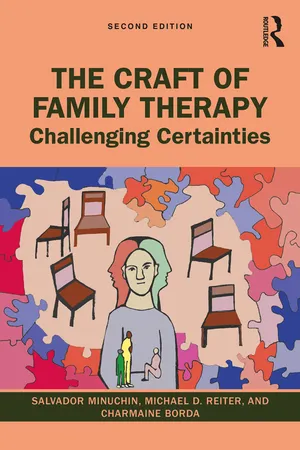
The Craft of Family Therapy
Challenging Certainties
- 264 pages
- English
- ePUB (mobile friendly)
- Available on iOS & Android
The Craft of Family Therapy
Challenging Certainties
About this book
This cutting-edge second edition of The Craft of Family Therapy revisits some of Salvador Minuchin's most famous cases, guiding trainee therapists through basic techniques and ideas while illuminating the unique voice of Minuchin as the founder of Structural Family Therapy.
The book begins by teaching readers the fundamentals of family therapy through the lens of rich commentary from Salvador Minuchin on some of his most interesting cases. It then moves on to three detailed supervision transcripts from Minuchin's former students, illustrating the struggles, fears, and insecurities that new family therapists face and how they can overcome them. In a new, ground-breaking third section, Reiter and Borda share their own lessons from Minuchin as well as expand his influential ideas, emphasizing a strength-based family therapy approach.
Written in an accessible, practical style, The Craft of Family Therapy, 2nd edition draws on a wealth of fascinating case examples to bring Minuchin's theory and experience to today's family therapists and psychotherapists in practice and training.
Frequently asked questions
- Essential is ideal for learners and professionals who enjoy exploring a wide range of subjects. Access the Essential Library with 800,000+ trusted titles and best-sellers across business, personal growth, and the humanities. Includes unlimited reading time and Standard Read Aloud voice.
- Complete: Perfect for advanced learners and researchers needing full, unrestricted access. Unlock 1.4M+ books across hundreds of subjects, including academic and specialized titles. The Complete Plan also includes advanced features like Premium Read Aloud and Research Assistant.
Please note we cannot support devices running on iOS 13 and Android 7 or earlier. Learn more about using the app.
Information
Part I
Concepts and Practice of the Craft
1 The Craft of Family Therapy
The Family Therapist Pouch
Basic Principles
Joining is the Essential Element
All Families that Come to Therapy are “Wrong” in their Assumptions
Table of contents
- Cover
- Endorsement
- Half Title
- Title Page
- Copyright Page
- Dedication
- Table of Contents
- Prologue
- Acknowledgments
- Part I Concepts and Practice of the Craft
- Part II Teaching and Learning the Craft
- Part III Extending the Craft of Family Therapy
- References
- Index